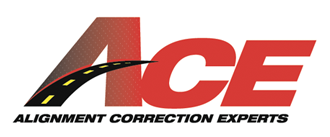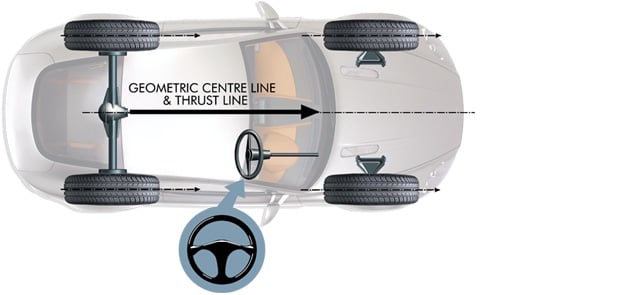
Does your car pull to one side? Are the tyres worn excessively, or unevenly? Do you have to constantly keep steering your car to travel straight ahead? These are the symptoms that your car is out of alignment.

Why is Wheel Alignment Important?
Wheel alignment plays a critical role in maintaining optimal vehicle performance and safety. Proper alignment ensures that all wheels are set at the correct angles, allowing tires to make even contact with the road surface. This alignment directly impacts tyre wear, fuel efficiency, and handling characteristics. With accurate alignment, tyres experience reduced wear, ensuring longer tyre life and improved fuel economy.
Additionally, precise alignment enhances vehicle stability, steering response, and overall driving comfort. Regular wheel alignment checks and adjustments are vital to prevent premature tyre wear, maximise fuel efficiency, and ensure a safe and enjoyable driving experience.
Wheel Alignment Explained
A wheel alignment essentially refers to all the elements that keep your vehicle going straight. A technician will need to manually adjust a vehicle's suspension system to realign your car.
A tyre and auto professional will tweak different suspension components to restore them to their correct setting during an alignment.
The main parts that are checked and adjusted during an alignment are:
Camber
The inward or outward tilt of your tyres when you look front on. If your camber is misaligned, you may have premature tyre wear on one or some of your wheels, and your vehicle seems to "pull".
Toe
When you view your tyres from above, it is the inward (positive) or outward (negative) angle. A slight misalignment of the toe will result in a reduction in tyre life. For minimum tyre wear and power loss, the wheel of a vehicle should be pointing straight ahead.
Caster
The angle of your steering axis when viewed side-on. If wheel has too little positive caster, you'll likely find your vehicle wanders and has difficulty keeping a straight line. If it has too much positive caster, it'll result in heavy steering.
Thrust
The thrust angle is an imaginary line drawn perpendicular from the centerline of the rear axle down the centerline of the vehicle. The thrust angle determines if the wheelbase on both sides of the car is the same.
More time is required when conducting a wheel alignment on a vehicle fitted with adaptive suspension (electronic damper control, manually adjustable suspension, and air suspension). Pricing on such vehicles may cost slightly more.
You can keep your vehicle running at peak performance when it is properly aligned. When you're due for your next wheel alignment, stop by JAX for affordable service and excellent care.
How a Wheel Alignment is Performed
There are three types of wheel alignments: two-wheel alignment, four-wheel alignment and thrust alignment. Your JAX technician will assess your vehicle for the right one for you based on its year, make and model.
Two-Wheel Alignment: Also known as "front-end" alignments. Technicians perform alignments only on the two front wheels as the rear portion of the suspension is not designed for adjustments.
Four-Wheel Alignment: As the name suggests, the alignment performed on all four wheels is typically only performed on all-wheel-drive vehicles.
Thrust Alignment: Thrust alignments alongside two-wheel alignment. These occur in cases where technicians ensure the front wheels align with the back wheels.
Many handling problems can be corrected by an alignment - with all the system components properly aligned, road shock is more efficiently absorbed for a much smoother ride.
The JAX Tyres & Auto Ace Alignment System offers two kinds of alignment:
Front Wheel Thrust Alignment:
This method ensures that the front wheels are aligned to the centre line of the vehicle. However, because the front wheels are not referenced to the alignment of the rear wheels the steering wheel may be off centre.
For vehicles without any rear suspension adjustment, the front wheels are aligned to the thrust angle of the rear wheels, ensuring that the vehicle tracks straight and the steering wheel is centred.

Front & Rear Wheel Alignment:
For vehicles with adjustable rear suspension, all four wheels are aligned to the geometric centre of the vehicle, ensuring that the vehicle tracks straight ahead and the steering wheel is centred.

When Is the Right Time for a Wheel Alignment?
The correct settings for wheel alignment are exact, so you’ll probably notice a difference in the feel and function of your car if you need an alignment.
There are a couple of ways to tell if your car needs a wheel alignment. If you've noticed any of these indicators, you should immediately have your alignment checked by a licensed service technician. Look out for the following symptoms:
- The steering wheel is crooked when you are driving straight: This may be a symptom of a change in the position of the wheels relative to the steering column.
- When you drive, your car pulls to either the left or right: Does your vehicle want to drift to the left or right when you briefly let go of the wheel? Do you have to constantly steer in the opposite direction to keep the vehicle driving straight? These are classic symptoms that the wheels are out of alignment.
- Squealing tires: Mild tyre squeak can be a symptom of weak springs in the suspension that cause one side of the car to sag.
- Excessive/uneven tyre wear: An excellent way to check is by measuring the tread depth to see if your wheels are misaligned. If the wheels are correctly aligned, they will all be the same.
How can a wheel alignment save you money?
Misaligned wheels can cause issues with fuel efficiency, increased tyre wear, and impact on safety and handling.
Saves on Fuel
When tyres aren't correctly aligned, they drag more, leading to premature tyre wear. It takes more fuel to get your vehicle moving, decreasing its fuel efficiency.
Saves Tyre Wear
Misalignment also leads to rapid tyre wear and the need for early tyre replacement. Alternatively, a car whose wheels are appropriately aligned will add thousands of miles to that car's tyre life over time.
Improved Handling
Misalignment caused by uneven tyre wear can increase the distance needed to come to a stop when braking. A mechanic will include a tyre and suspension inspection during a wheel alignment check.
Can I get Wheel Alignment Near Me?
Wheel misalignment can happen from something as simple as hitting the kerb or driving over a pothole. We recommend taking the time to check your wheel alignment regularly. It's an excellent way to notice problems before they become more severe and save money on fuel and parts.
At JAX, we have expert, friendly technicians all across Australia, ready to help you with any of your vehicle needs. Your nearest JAX Tyres & Auto Store can advise specific recommendations for your vehicle.
A wheel alignment or tyre alignment is a manual adjustment of a vehicle’s suspension system. During an alignment a tyre and auto professional will tweak different suspension components to restore them to their correct setting. Adjusting your car’s suspension system can improve overall handling, prevent issues with steering, and help your tyres last longer.
The three main parts that are checked and adjusted during an alignment are:
- Camber: The inward or outward tilt of your tyres when you look front on.
- Toe: The inward or outward angle when you view your tyres from above.
- Caster: The angle of your steering axis when viewed side on.
The correct settings for wheel alignment are very precise so you’ll probably notice a difference in the feel and function of your car if you need an alignment. Look out for the following symptoms:
- The steering wheel is crooked when you are driving straight
- Unusual sounds when steering
- Your car pulls to either the left or ride when you drive
- Squealing tires
- Excessive / uneven tyre wear
- Wheel alignments are usually conducted as part of your regular scheduled
servicing. - But, you should also consider booking in for an alignment if you have:
- Recently replaced a part of your steering or suspension
- Driven over a large bump or experienced a sudden jolt when driving.
- Been involved in an accident that caused you to jerk your breaks.
Some symptoms of misalignment:
- squealing tyres
- unusual sounds when driving
- a pull to the side when steering
- Tyres wearing down quickly or unevenly
- Your steering wheel is not centred when you’re driving straight
There is no set amount of time that a wheel alignment is guaranteed to last for.
This is because misalignment can happen from something as simple as hitting the kerb or driving over a pothole. For this reason, it is recommended that you have a wheel alignment twice a year or every 10,000km (whichever comes first).
And if you notice anything out of the ordinary with your steering or tyres, book in with a professional immediately for a check. They will be able to properly examine your car and advise whether a wheel alignment is necessary or not.
Misaligned wheels can cause issues with fuel efficiency, increased tyre wear, and impact on safety and handling.
When tyres aren’t correctly aligned they tend to drag more which means the vehicle needs more fuel to get moving.
Misalignment also leads to rapid tyre wear and the need for early tyre replacement.
The most serious impact of bad wheel alignment is the impact on handling. It may seem trivial but could cause more serious safety issues if you need to make an emergency manoeuvre and your car doesn’t respond as it should.
It is strongly recommended that you have a wheel alignment when you have new tyres put on your vehicle.
An alignment helps to extend the life of your tyres and keep you safe on the road by ensuring all tyres meet the road at the correct angle and are properly centred.
This means better fuel mileage, increased longevity of your tyres and better handling and response - essential for your safety, and the safety of others on the road.

